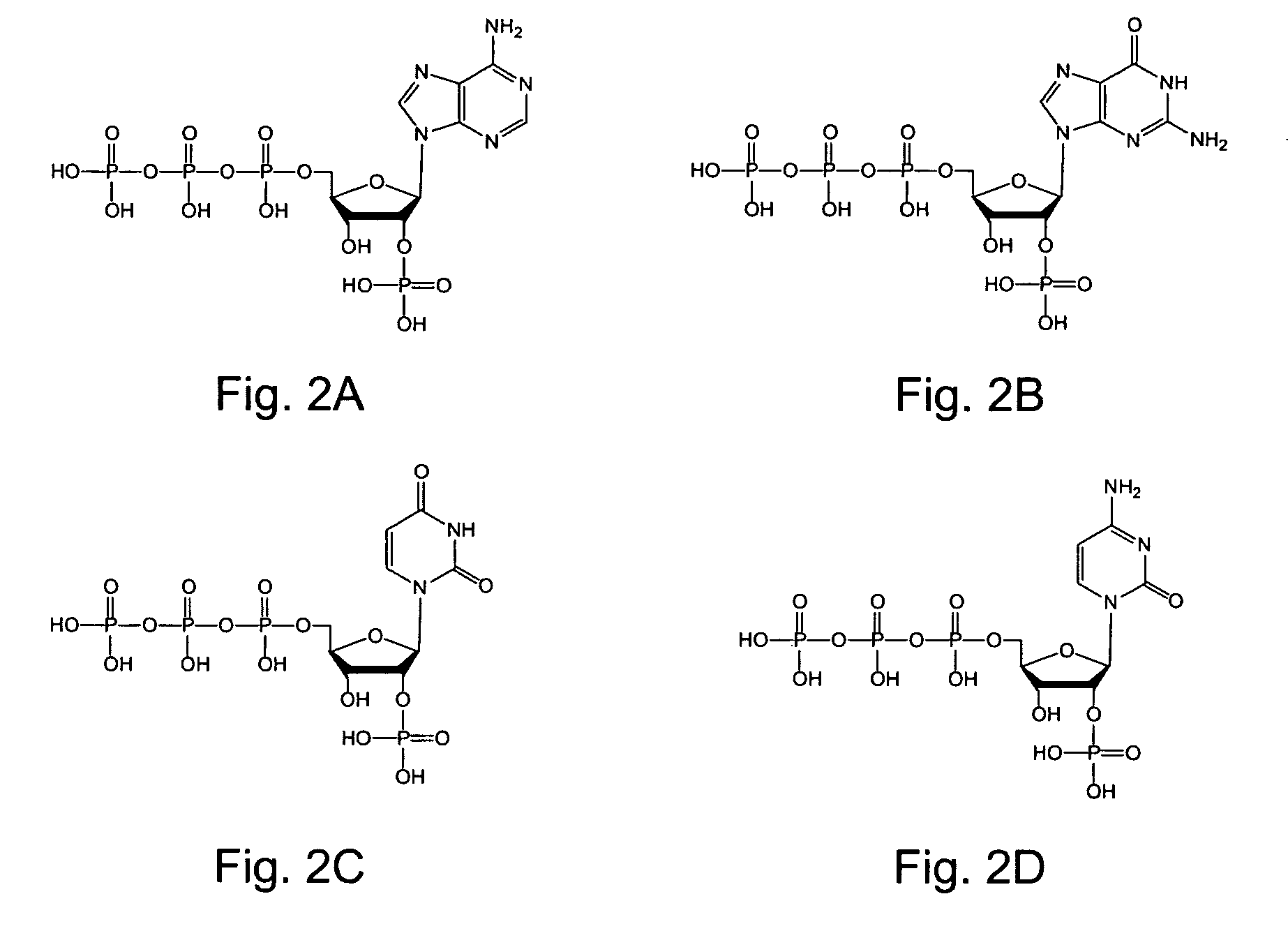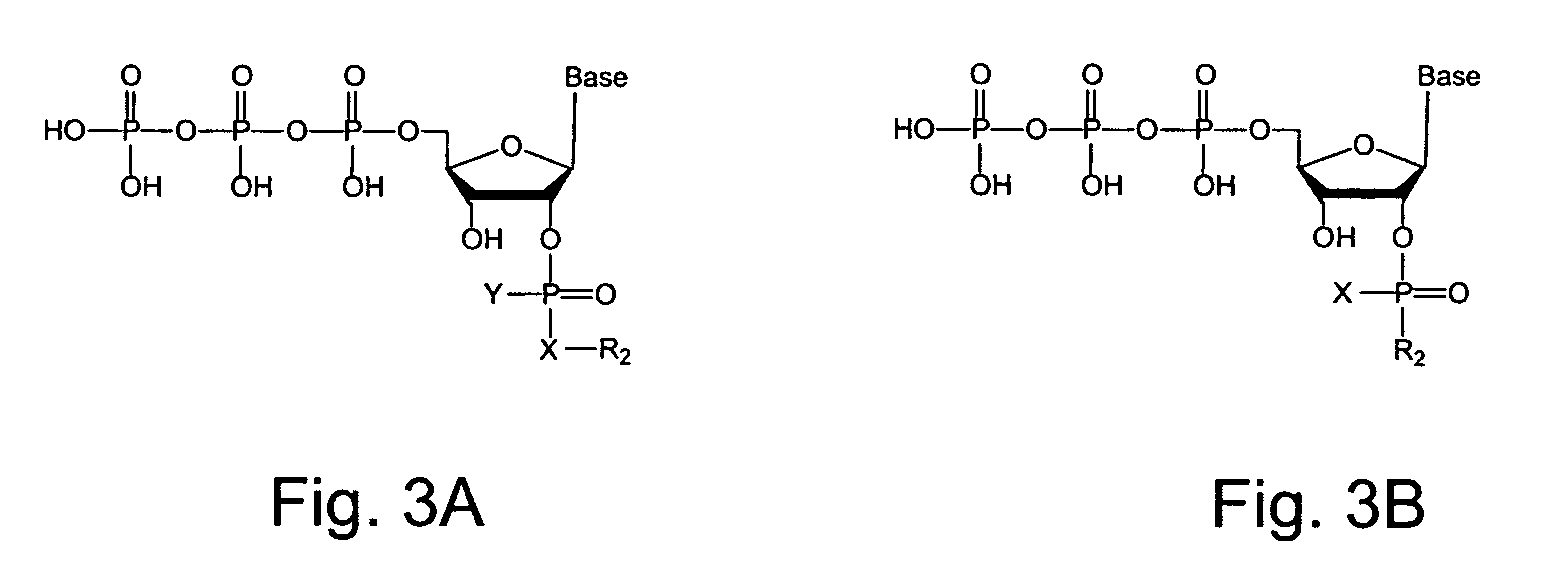2′-terminator related pyrophosphorolysis activated polymerization
a pyrophosphorolysis and activated polymerization technology, applied in the field of nucleic acid chemistry and molecular biology, can solve the problems of compromising the efficiency of full-length primer extension products in each cycle, affecting the efficiency of pcr cycle of these previous approaches, and causing limited, if any, non-specific products
- Summary
- Abstract
- Description
- Claims
- Application Information
AI Technical Summary
Benefits of technology
Problems solved by technology
Method used
Image
Examples
example i
Synthesis of Blocked Oligonucleotides
[0193]2′-O-PO3 blocked oligonucleotides (FIG. 5) were synthesized on an automated Applied Biosystems 394 synthesizer using standard β-cyanoethylphosphoramidite chemistry (FIG. 6). The solid support used in the synthesis of these oligonucleotides was 3′-phosphate CPG (from Glen Research, # 20-2900-41), which facilitated the introduction of a phosphate group at the 3′-end of an oligonucleotide. In the first cycle of the synthesis, the ribonucleoside-2′-O-phosphoramidite (FIG. 7, where B=Bases; Adenosine (part # ANP-5681), Cytidine (ANP-5682), Guanosine (ANP-5683) and Uridine (ANP-5684)) purchased from ChemGenes, was used to couple with solid-support. In the second cycle of the synthesis and thereafter, the standard deoxynucleoside phosphoramidites were used. After the synthesis, the oligonucleotides were cleaved from the solid support and deprotected with concentrated ammonium hydroxide at room temperature for 24 to 48 hours. The ammonium hydroxide...
example ii
HIV DNA Template Titrations
[0194]PAP-related HIV DNA template titrations were performed with and without the presence of genomic DNA. FIG. 8 is a photograph of a gel that shows the detection of the PCR products under the varied reaction conditions utilized in this analysis. This data illustrates, e.g., the improved amplification specificity and sensitivity that can be achieved using the blocked primers described herein relative to reactions not using those primers.
[0195]More specifically, the reactions were performed using an ABI 5700 Sequence Detection System with the following temperature profile:[0196]50° C. 2 minutes[0197]93° C. 1 minute[0198]93° C., 15 seconds→52° C., 4 minutes×4 cycles[0199]90° C., 15 seconds→55° C., 4 minutes×56 cycles
The following reaction conditions were common to all reactions:
[0200]
Master Mix Componentsconc.Tricine (pH 8.0)100 mMdATP200 μMdCTP200 μMdGTP200 μMdTTP30 μMdUTP300 μMPrimer 3 or Primer 1200 nMPrimer 4 or Primer 2200 nMKOAc110 mMSYBR Green I0.2XN...
example iii
Amplification of Mutant K-Ras Plasmid Template in a Background of Wild-Type K-Ras Plasmid Template
[0204]Amplifications involving various copy numbers of mutant K-Ras plasmid template in a background of wild-type K-Ras plasmid template and comparing blocked and unblocked primers were performed. FIG. 9 is a graph that shows threshold cycle (CT) values (y-axis) observed for the various mutant K-Ras plasmid template copy numbers (x-axis) utilized in these reactions. FIG. 9 further illustrates, e.g., the improved discrimination that can be achieved using the blocked primers described herein.
[0205]The reactions were performed using an ABI 5700 Sequence Detection System with the following temperature profile:[0206]50° C. 2 minutes[0207]93° C. 1 minute[0208]92° C., 15 seconds→65° C., 2 minutes×60 cycles
The following reaction conditions were common to all reactions:
[0209]
Master Mix Componentsconc.Tricine (pH 8.0)100 mMdATP200 μMdCTP200 μMdGTP200 μMdTTP30 μMdUTP300 μMPrimer 7 or Primer 5200 n...
PUM
| Property | Measurement | Unit |
|---|---|---|
| wavelength | aaaaa | aaaaa |
| wavelength | aaaaa | aaaaa |
| wavelength | aaaaa | aaaaa |
Abstract
Description
Claims
Application Information
 Login to View More
Login to View More - R&D
- Intellectual Property
- Life Sciences
- Materials
- Tech Scout
- Unparalleled Data Quality
- Higher Quality Content
- 60% Fewer Hallucinations
Browse by: Latest US Patents, China's latest patents, Technical Efficacy Thesaurus, Application Domain, Technology Topic, Popular Technical Reports.
© 2025 PatSnap. All rights reserved.Legal|Privacy policy|Modern Slavery Act Transparency Statement|Sitemap|About US| Contact US: help@patsnap.com



